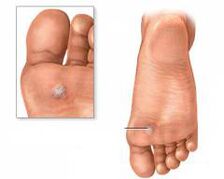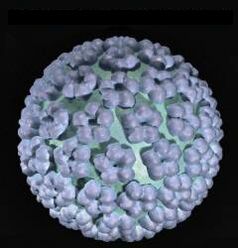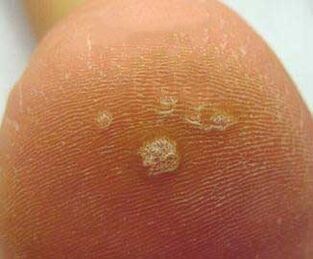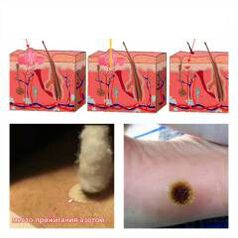
Plantarwartsis a benign growth of epithelial cells in the form of small growths caused by the human papillomavirus. This manifestation is localized directly in the support area of the foot or toe.
Interesting facts:
- According to statistics, the manifestations of plantar warts are most often observed between the ages of 20 and 30 years.
- In most cases (more than 50%) plantar warts can heal on their own without treatment.
- According to various sources, carriers of HPV (human papillomavirus) are from 70 to 90 percent of the world's population.
- Plantar warts are known as "thorns". This interpretation is associated with thorns, which are painful to step on.
- A large number of HPV types affect the skin.
Causes of warts
Warts are viral skin diseases caused by human papillomavirus.
There are about a hundred types of this virus. They can enter the human body and do not appear for a long time, thanks to the protective properties of the body such as:
- immunity;
- phagocytosis (is a nonspecific immune defense reaction, i. e. when a pathological agent enters the body, the phagocytes surround it and destroy it).
The risk of contracting the human papillomavirus virus depends on the following factors:
- virus activity in human carriers;
- contact properties (direct or indirect relationships);
- the immunity status of the infected person.
70 - 90% of people are carriers of the human papillomavirus, however, whether warts occur or not depends on the state of immunity. People with reduced immune system are more prone to manifestations of warts. Also, the risk of getting warts increases when cases when the body is affected by adverse factors (for example, stress, fatigue, insomnia, poor hygiene), which cause weakening of the immune system.
The papilloma virus can be transmitted through contact with people who have warts, for example, through handshakes, shared items (towels, sandals);
There are the following predisposing factors for human papillomavirus infection:
- leg sweats (skin becomes looser, and the penetration of various infections through it is facilitated);
- frequent washing, cleansing (frequent skin irritation with various detergents damages the skin's protective barrier and, thus, facilitates virus penetration)
- microtrauma of the skin or mucous membranes (cracks, scratches, abrasions are the gateway to infection to enter the body);
- uncomfortable tight shoes that provoke rubbing of the skin of the feet (chunks, abrasions are also the gateway to infection to enter the body);
- diseases that lead to malnutrition in the epithelium of the feet (for example, diabetes mellitus, atherosclerosis);
- viral infections can occur through pedicure instruments (if the instrument has not been disinfected);
- public baths, saunas or swimming pools (places where the feet come in direct contact with the floor surface that may be infected).
Human skin is made up of epidermis, dermis and subcutaneous fat. Human papillomavirus, penetrating skin tissue, affects the basal layer of the epidermis. Afterwards, multiplying, the virus-infected cells appear through all layers of the epidermis and are localized to the superficial epithelial stratum corneum, appearing on the outside with rough skin and keratin.
Human papillomavirus

HPV is a papovavirus family infection that affects the mucous membranes of organs (usually the genitals), as well as skin epithelial cells. Papillomavirus contains DNA (deoxyribonucleic acid), which, when introduced into the human body cells, provokes the production of new viral particles.
All types of HPV can be roughly divided into two groups:
- papillomavirus with oncogenic properties;
- papillomavirus that does not have oncogenic properties.
Note:oncogenic properties contribute to the formation of malignant tumors.
Today, there are more than a hundred types of human papillomavirus. Plantar warts, as a rule, are caused by the first type of HPV, in some cases its formation can provoke the second and fourth types (non-oncogenic papillomavirus).
HPV is usually found in every person who has sex. Eight out of ten people are infected with the virus. Of all HPV types, 6, 11, 16 and 18 are isolated as the most dangerous. This type of HPV can cause papilloma, condyloma and cancer.
Symptoms and forms of warts on the legs
Human papillomavirus, which penetrates into tissues, can be passive or active.
- Passive conditions are characterized by the fact that the virus, which is in the basal layer of the epidermis, reproduces slowly, does not reach the stratum corneal epithelium, therefore, this condition does not manifest itself externally.
- An active condition is characterized by the fact that the virus is actively developing and, rising to the top layer of the epidermis, manifests itself with many symptoms.
| Feature | Fade in | Foto |
| Shiny surface | Initially, plantar warts appear as sparkling plaques, then the surface is keratinized, becoming rough and coarse. |  |
| Dimensions | Plantar warts measure one to two centimeters and rise above the surface of the epithelium one to three millimeters. Often, warts are oval or round in shape. There is also the concept of mother and daughter warts. Maternal warts appear first and foremost; as a rule, smaller girls' warts can form around them. Over time, mother and child warts can join together to form large wounds. | |
| Soreness | Plantar warts are located on the legs, which carry most of the weight. Warts are compressed between the palms and bones, causing the surrounding tissue to harden. These warts are, in most cases, very painful due to the fact that the warts can press on the nerves in the legs, causing pain while walking. | |
| Warna | Most warts are light brown or yellowish-white. | |
| Blackheads | If the stratum corneum is removed from the surface of the wart, dark spots may appear on the bed of the affected area, which is formed due to the fact that the bleeding capillaries in this area are throbbing. This feature is characteristic of plantar warts from corn and calacity. |
Single wart removal

Currently there are many effective and safe treatments for plantar warts. It should be noted, however, that in some cases, the removal of trusted warts can be complicated by the fact that the human papillomavirus virus penetrates to the innermost layer of the epidermis (to the basal layer).
Wart treatment is required if:
- sore warts;
- bloody warts;
- large warts;
- uneven wart color (for example, spots appear inside);
- there is a rapid growth rate of warts.
There are the following methods to get rid of plantar warts:
- crushing;
- laser freezing;
- electrocoagulation;
- radio wave surgery;
- surgical surgery.
Cryodestruction Generation
This method involves exposing warts to liquid nitrogen with a temperature of minus 196 degrees. Cryodestruction is characterized by the fact that when the warts freeze, the skin-affected areas of the virus are destroyed, followed by stimulation of the immune system. However, it should be noted that if warts appear and exist for up to six months, then the effectiveness of their removal is 84%. While the effectiveness of removing existing warts for more than six months is reduced to 39%.
Code-breaking procedure can be performed:
- is usually (liquid nitrogen is used until a circle of light with a diameter of two millimeters appears around the wart);
- aggressively (after the appearance of light circles around the warts, liquid nitrogen continues to be used for another five to twenty seconds).
Research has shown that aggressive methods of freezing warts are more effective than conventional methods, but the downside is that they are more painful.
After removal of the wart at the site of exposure, there is hyperemia (redness) on the skin, followed by the formation of edema. A few hours later, bubbles form in the affected area (may contain hemorrhagic or serous fluid), and about six to seven days after the bladder dries, a crust forms in its place, disappearing within two weeks.
After removing the warts, follow these guidelines:
- blisters formed at the site of warts cannot be opened;
- the affected area should not be covered with adhesive tape;
- it is recommended to wrap the exposure site with a sterile bandage without tightening to prevent mechanical damage and contamination of the affected area;
- it is recommended to treat the affected area with 2% salicylic alcohol twice a day;
- try to avoid water ingress at the site of exposure.
| Advantages of Method | Weaknesses of methods |
| tissue heals without scars | if exposure to liquid nitrogen occurs superficially, there is a high probability that the lump (remodeling) warts |
| the procedure is performed without the use of local anesthesia | local hypo- or hyperpigmentation may occur after the procedure |
| removing warts with this method takes one to two minutes | if it goes deeper, there is a risk of scarring |
Laser freezing
Removing warts with a laser beam is one of the most common treatment methods today. This method is characterized by layer by layer of the affected area, which allows you to control the depth of exposure. Also, when removing warts, laser beams simultaneously sell the vessel, thus preventing bleeding at the site of exposure.
The following laser freezing methods are available:
- Carbon dioxide (CO2) - laser.Warts are exposed to infrared light (wavelength is 10 600 nm). The disadvantage of this method of treatment is that tissue cauterization is not selective, i. e. there is a possibility of damage to healthy tissue. The efficiency of removal of plantar warts using carbon dioxide laser is 70%.
- Laser Erbium.This method is characterized by a shorter wavelength of 2940 nm, which significantly reduces the likelihood of scarring after tissue epithelialization. The effectiveness of this treatment method is 75%.
- Laser pulsation dye.This method is characterized by selective energy absorption (wavelength of 586 nm) oxygenated hemoglobin, in which diluted capillary destruction on warts occurs, as well as stimulation of the immune system, which contributes to effective healing. The effectiveness of this treatment method is around 95%.
After laser treatment, a crust forms on the affected area, which disappears on its own within seven to ten days. It is not advisable to tear the crust, as well as lubricate with something (ointments, creams, alcohol solutions). Also, in the first few days after the procedure, water should be avoided in the exposed area.
| Advantages of Method | Weaknesses of methods |
| tissue heals without scars | disadvantages of this method only include high procedural costs |
| fast tissue healing | |
| low risk of recurrence (recurrence) | |
| hardly affects healthy tissue |
Electrocoagulation
Plantar warts are prone to high frequency current. Cleaning of the affected area should be done under local anesthesia. Thanks to the coagulation loop applied to the affected skin area, an electric current is applied to the warts, which causes its death. Also, the action of high temperatures causes vessel soldering, which prevents the development of bleeding.
After the procedure, a thick crust forms at the site of exposure, which disappears on its own within ten days.
After removing the warts, follow these guidelines:
- during the healing period, try to avoid water or soap on the affected skin area;
- the crust formed cannot be touched or torn;
- In the first seven to ten days, it is recommended to treat the site of exposure with antiseptic once or twice a day.
| Advantages of Method | Weaknesses of methods |
| cost of available procedures | for small, shallow warts |
| prevents bleeding | when applied to the deep layers of skin after tissue healing, scars may remain |
| the procedure takes from a few seconds to a minute | removal of superficial warts can cause relapse |
Radio wave surgery
This treatment method consists of using a special electrode that emits high frequency radio waves (3, 8 - 4, 0 MHz). Exposure to high temperatures on plantar warts causes evaporation of cells affected by the papilloma virus. Also, due to the cleansing of blood vessels, the use of this method prevents the development of bleeding. After exposure, crusts form on the affected skin area, which disappears on its own within seven to ten days.
Contraindications during the healing period:
- in the first two days after the procedure, you can not wet the moxibustion site;
- peel off the crust in seven to ten days.
| Advantages of Method | Weaknesses of methods |
| when exposed to the affected area, healthy tissue is practically unaffected | high procedure costs |
| there is a minimum risk of scarring after tissue healing | |
| low risk of remission after treatment (two to five percent) |
Surgical excision
This method is characterized by the removal of warts with a scalpel under local anesthesia. After cutting the affected area, sutures are applied, which are removed after seven to ten days.
| Advantages of Method | Weaknesses of the method |
| is used to get rid of large warts | after removing the stitches, the affected area may be scarred |
| there is a risk of remission (loss of symptoms) warts |
General principles of treating affected skin areas after wart removal:
- if a crust is formed, it cannot be touched or torn;
- restrict water intake to affected areas;
- after removing warts, it is impossible to display websites exposed to direct sunlight;
- there are no cosmetic products (such as creams or lotions) that can be applied to the affected skin area;
- it is not recommended to visit a public sauna, bath or pool for one to two months after the removal of the wart;
- after removing warts, it is recommended to use vitamins A, C and E, as it stimulates tissue regrowth (healing), and also stimulates the body's defenses.
Note:If complications arise after removing the warts (inflammation of the affected area, prolonged healing, scarring), you should contact your doctor as soon as possible.
For all treatment methods, the contraindications to the procedure are:
- diabetes mellitus;
- presence of malignant tumor;
- pregnancy;
- infectious and inflammatory diseases near warts;
- herpes enlargement;
- increase in body temperature;
- high blood pressure (exceeds 140 per 100 millimeters of mercury).
Treatment of warts without surgery
For single and superficial plantar warts, it is recommended to use traditional treatment methods.
| The name of the tool used | Cooking | Apply |
| Acetic Acid | You need to buy 70% acetic acid, petroleum jelly, and prepare a pipette to use the correct dosage. | Before applying acetic acid, apply petroleum jelly on healthy skin around the warts. Then, using a pipette, one drop of acetic acid should be applied to the wart. Use this method once a day until the warts disappear. |
| Garlic Infusion | You need to chop three cloves of garlic, and then pour the resulting mass of boiling water (50 ml). After one hour, the resulting infusion must be filtered and applied. | Lubricate the wart area with the infusion produced once a day until its formation is completely gone. |
| Saline solution | Dissolve one tablespoon of salt in warm water (100 ml) and add one tablespoon of vinegar (9%). The resulting solution must be thoroughly stirred, and then the pulp of one plum should be dipped into it and infused for two hours. Once time has passed, it is necessary to remove the plums from the solution and grind them into gruel. |
The plum plum produced must be applied to warts. For safety fit, wrap your feet and put socks on. This compress should be left on for two to three hours. The procedure should be repeated daily until the warts disappear completely. |
| Wormwood infusion | Add three tablespoons of dried wormwood to a glass of hot water (250 ml), cover and set for two hours. |
The resulting solution should be applied to the affected foot area three to four times a day until the warts come out. |
| Lemon skin infusion | You need to peel two lemons and put them in a 1 liter jar, crushed. Then add 100 ml of 9% table vinegar to the vessel and close the jar with a tight lid. The contents should be injected for a week, shaking the jar periodically. At the end of the period, the infusion must be filtered. | The resulting infusion should be moistened with warts twice a day until it disappears completely. |
| St John's wort decoction | For one glass of water (250 ml) add a tablespoon of St. John's wort. John chop and simmer for 15 minutes over low heat. Once cooked, the gravy must be cooled and then filtered. | With the resulting broth, you need to lubricate the warts three to four times a day until they disappear completely. |
| Note:If there are any side effects, you should see a doctor immediately. | ||
Currently, celandine is also used effectively in the treatment of plantar warts. This plant has a yellow-orange medicinal juice.
Celandine has the following medicinal properties:
- bactericides (cause the death of hidden microorganisms);
- anti-inflammatory;
- antispasmodik;
- choleretic;
- antivirus;
- wound healing;
- warns;
- antipruritic;
- celandine also contains vitamins A and C.
When treating plantar warts, fresh celandine juice is used, which must be applied to the affected skin two to three times a day until the warts disappear completely. Before using celandine, it is recommended to carefully soak your feet in hot water and remove the warts that have been glued.
In the treatment of plantar warts, celandine has the following therapeutic effects:
- helps reduce pain while walking;
- accelerates the process of drying warts and crust formation;
- , due to its content of vitamins A and C, stimulates local immune responses.
Celandine also contains a variety of acids (ascorbic, suksinic, malik, citric), which are sensitive to HPV.
To increase the effectiveness of treatment of plantar warts, the following recommendations should be considered:
- perform daily hygiene procedures for the feet;
- to strengthen the immune system, vitamins should always be used (for example, vitamins A, E, C);
- use their respective shoes (for example, house slippers);
- with dry foot skin, it is necessary to always use a moisturizing and nourishing foot cream;
- in public places (baths, saunas or swimming pools) personal slippers should be used and footwear should be avoided;
- choose the right shoes carefully (e. g. the right size, natural materials);
- In case of excessive foot sweating, it is necessary to use a drying agent, and also try to choose shoes according to the weather.























